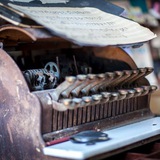group-telegram.com/random_from_sherlock/496
Last Update:
How a single invention changed the course of history.
Until recently I struggled to understand how the Dutch Republic, a tiny newly established state on the European periphery, could dethrone the Portuguese Empire in a spice trade. It's not exactly that Iberian sailors were schoolboys. On the contrary, they were instrumental in imposing their power on locals of the Indian subcontinent and islands of the Far East. They epitomized the state of the art in shipbuilding and navigational know-how of the era. And yet, the Dutch prevailed. But a little historical context first.
- On May 4th, 1493, Pope Alexander VI issued a bull "Inter caetera" to divide the newly discovered world between Spanish and Portuguese monarchies.
- In 1494 the Treaty of Tordesillas was negotiated to better define boundaries.
- Portugal discovered the Spice Islands (modern Indonesia) in 1512.
- 1568 –1648, Eighty Years' War. Dutch ultimately succeeded in gaining independence from Habsrubgs.
- In 1580 the Iberian Union was formed. A previously neutral Portuguese Empire entered the ongoing conflict with the Dutch, on the side of Spain. Hostilities expanded to the high seas.
- 1595 – 1597, the First Dutch Expedition to the East Indies. It had limited success, however, it demonstrated the viability of the enterprise and opened the door for future expeditions.
- In 1602 The Dutch East India Company (VOC) was formed. It is one of the first joint-stock companies in the world and a significant financial innovation by itself. The opportunity to invest was open to all members of society.
- 1628, The Portuguese established the Portuguese East India Company, a joint-stock company with the king as the majority shareholder. Portuguese dominated east trade in this period.
A stage was set in the late 16th century, and early 17th century, for a trade and military competition between the Dutch and the Portuguese over the spice trade. It later developed into a conflict known as the Dutch-Portuguese War of 1598-1663. Not only did the Dutch come up on top, but they also managed to defeat England in the Second Anglo-Dutch War (England was victorious in the first one). Brits were getting upset with the Dutch monopolizing the trade. Not to mention several wars against a little catholic fellow known as Louis XIV of France. The Dutch Republic entered its Golden Age.
Arguably, a single invention, by a modest farmer catapulted the Dutch to its zenith. In 1594, Cornelis Corneliszoon van Uitgeest developed a machine to harness wind power to saw wood. He built his first sawmill. The critical component of his design was a crankshaft, which converted circular motion into back-and-forward motion powering the saw. He made additional improvements in the subsequent years and obtained a few patents. Initially, local carpenters opposed the invention, but very quickly the whole society realized the benefits, for plenty of ordinary citizens were VOC investors. Productivity soared by a factor of 30 (3,000%). The Dutch started to crank out ships at unrivaled speeds and quantities.
By the early 1600s, the Dutch Republic became the world's foremost naval power. The Spanish fleet was destroyed in 1607 at the Battle of Gibraltar. By 1650, the Netherlands had about 16,000 merchant ships. In 1667, in Raid on the Medway, the Dutch delivered a crushing naval defeat to England. The next year, William III aka William of Orange, toppled James II and put himself on the British throne, to end the beef with England.
This fascinating story underscores the importance of technological innovation and its application to the balance of power. This is especially breathtaking if one considers the population of competing powers in the 17th century.
Iberian Union and possessions ~ 28.7M
England and possessions ~ 5.6M
Kingdom of France ~18-20M
Dutch Republic ~1.5M
The U.S. can trace its innovative dynamism to the Dutch lineage.
#history
BY Random Thoughts
Warning: Undefined variable $i in /var/www/group-telegram/post.php on line 260
Share with your friend now:
group-telegram.com/random_from_sherlock/496
